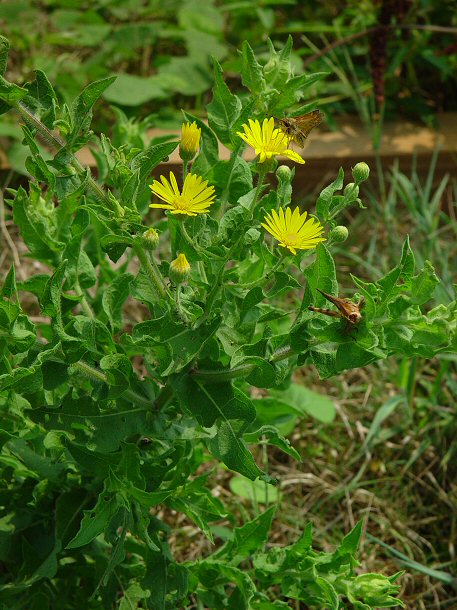Heterotheca subaxillaris (Lam.) Britton & Rusby
Camphor Weed

Native
CC = 2
CW = 5
MOC = 24
© DETenaglia
Heterotheca subaxillaris (Lam.) Britton & RusbyCamphor Weed | |
 |
Native CC = 2 CW = 5 MOC = 24 |
© DETenaglia |
|
Family - Asteraceae/Astereae Stems - To +1.5m tall, erect to ascending, multiple from base, herbaceous, from taproot, branching, scabrous to viscid, hirsute, glandular, reddish.
Leaves - Alternate, sessile(the lowest sometimes petiolate), auriculate-clasping, viscid, glandular, hirsute, fragrant, serrate-dentate(teeth mucronate), undulate, to 5cm long, 3cm broad, acute, dense on stem. Lower leaves often with two lateral lobes at base, appearing as stipules. Upper leaves simple.
Inflorescence - Single flower heads terminating branches. Involucre - Cylindrical, to +8mm tall, 1cm in diameter. Phyllaries viscid, sparse pubescent externally, glabrous internally, imbricate, linear, the longest to 7mm long, 1mm broad. Margins scarious. Sometimes with reddish tip.
Ray flowers - Flowers fertile. Corolla tube pubescent. Ligule yellow, 1.4cm long, 2.1mm broad, glabrous. Achene (in flower) white, thickened, 2mm long, somewhat triangular, mostly glabrous. Pappus absent. Disk flowers - Disk to 1cm broad. Corolla yellow, 5-lobed, glabrous, to 4.5mm long. Lobes acute, -1mm long. Stamens 5, adnate at base of corolla tube, included. Anthers yellow, 2.2mm long, connate around style. Style bifurcate, slightly exserted. Achenes dense pubescent, 2mm long, white, weakly 4-angled. Pappus in two series. Outer series of short scales. Inner series of capillary bristles. Receptacle flat.
Flowering - August - November. Habitat - Loess hills, waste ground, roadsides, railroads. Origin - Native to U.S. Other info. - This species can be found mainly in the southeast corner of the state but is also present in a few more scattered counties. This is a fairly easy plant to ID in the field. The glandular hirsute stems and leaves plus the cylindric involucres are good characteristics for a positive ID. The ray florets lack a pappus, which serves to differentiate this species from its sibling, H. camporum. The leaves are also fragrant. Many taxonomists disagree about the nomenclature of the plant but let's not worry about that here. Photographs taken in Vale, NC., 8-23-03 (DETenaglia); also on Ellis Island, St. Charles County, MO, 7-3-2017 (SRTurner). |